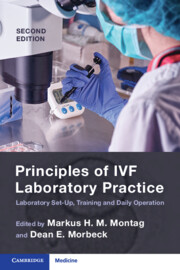Book contents
- Principles of IVF Laboratory Practice
- Principles of IVF Laboratory Practice
- Copyright page
- Contents
- Contributors
- Foreword
- The Evolution of IVF Practice
- Section 1 Starting a New Laboratory and Training Protocols
- Section 2 Pre-procedure Protocols
- Section 3 Gametes
- Section 4 Insemination/ICSI
- Section 5 Fertilization Assessment
- Section 6 Embryo Assessment: Morphology and Beyond
- Section 7 Embryo Cryopreservation
- Chapter 35 Zygote Cryopreservation for IVF
- Chapter 36 Cryopreservation of Pre-compaction Embryos for IVF
- Chapter 37 Cryopreservation of Post-compaction Embryos for IVF
- Chapter 38 Safe and Effective Cryostorage of Embryos for IVF
- Section 8 Embryo Transfer
- Section 9 Quality Management
- Index
- References
Chapter 36 - Cryopreservation of Pre-compaction Embryos for IVF
from Section 7 - Embryo Cryopreservation
Published online by Cambridge University Press: 07 August 2023
- Principles of IVF Laboratory Practice
- Principles of IVF Laboratory Practice
- Copyright page
- Contents
- Contributors
- Foreword
- The Evolution of IVF Practice
- Section 1 Starting a New Laboratory and Training Protocols
- Section 2 Pre-procedure Protocols
- Section 3 Gametes
- Section 4 Insemination/ICSI
- Section 5 Fertilization Assessment
- Section 6 Embryo Assessment: Morphology and Beyond
- Section 7 Embryo Cryopreservation
- Chapter 35 Zygote Cryopreservation for IVF
- Chapter 36 Cryopreservation of Pre-compaction Embryos for IVF
- Chapter 37 Cryopreservation of Post-compaction Embryos for IVF
- Chapter 38 Safe and Effective Cryostorage of Embryos for IVF
- Section 8 Embryo Transfer
- Section 9 Quality Management
- Index
- References
Summary
Improvement in the success of cryopreservation has increased the use of human embryos produced from ovarian hyper-stimulation and in vitro fertilization (IVF)/intracytoplasmic sperm injection (ICSI). High survival and implantation rates of frozen–thawed embryos have allowed for a decrease in the number of embryos transferred and even made way for a modern ‘freeze all’ approach, where all embryos derived from a fresh cycle are frozen and transferred in a subsequent frozen embryo transfer cycle. In recent years, cryopreservation has evolved to include vitrification, with many laboratories preferring this sometimes faster method, which also requires less complex equipment. However, slow freezing can often be more successful, cost-effective and faster than vitrification, particularly in zygotes and cleavage-stage embryos. For most vitrification approaches, the process is the same, independent of the embryo’s stage of development. Blastocyst vitrification can be applied for cleavage-stage embryos, and this chapter will focus on slow freezing of pre-compaction embryos.
- Type
- Chapter
- Information
- Principles of IVF Laboratory PracticeLaboratory Set-Up, Training and Daily Operation, pp. 263 - 270Publisher: Cambridge University PressPrint publication year: 2023

